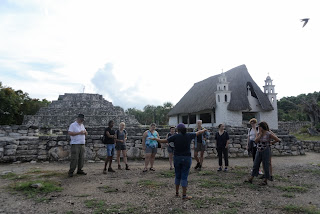A Visit to the Coast and our Return to Merida Before beginning the next stage of our program in San Felipe, a small coastal community on the northern edge of the Yucatan Peninsula, we visited the Biosphere Reserve of Ria Lagartos for a boat tour of the estuary. During this tour, we learned about the importance of different types of mangroves, we saw the diverse species of migratory birds that arrive to nest in this region and we admired the endemic bird species that are a key part of the mangrove ecosystem. We also were lucky enough to see majestic groups of flamingos, different types of fishing eagles, herons, pelicans, cormorants, gulls, frigates, plovers and of course, the stars of the “Ria”, Morelet’s crocodiles! Once in the community of San Felipe, the process of meeting our new host families is always a clash of the nerves and excitement that are natural when entering into a completely new sociocultural context. Above all, it is a new opportunity to meet people with big hear...

















